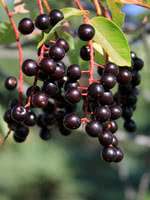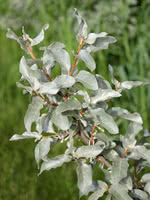Mon-Fri 9am - 5pm Mountain time
Western Chokecherry vs Silverberry (Wolf Willow)
Prunus virginiana var. demissa
Elaeagnus commutata
SOLD OUT
Western Chokecherry is a shrub or small tree commonly used for farmstead and field windbreaks.
It produces white flowers in the spring and edible dark purple fruit that matures between September and October. Its cherries are great for making for making jams, jellies or wine, but are not very palatable for raw eating.
Silverberry (also known as Wolf Willow) is a common native North American shrub. This beautiful ornamental plant has characteristic silver leaves and fragrant yellow flowers.
Its silver berries remain on the branches through the winter. Silverberry is cold hardy and has some ability as a nitrogen fixer. It can grow on dry to moist sandy/gravel soils. This plant is very low maintenance.
Western Chokecherry Quick Facts
Silverberry (Wolf Willow) Quick Facts
Toxicity: toxic to horses, cattle, etc.)

